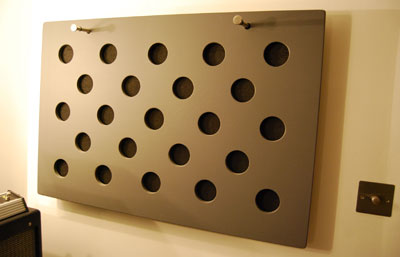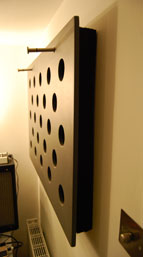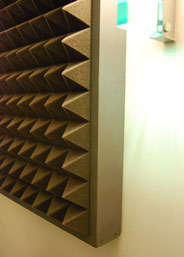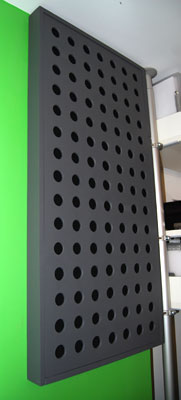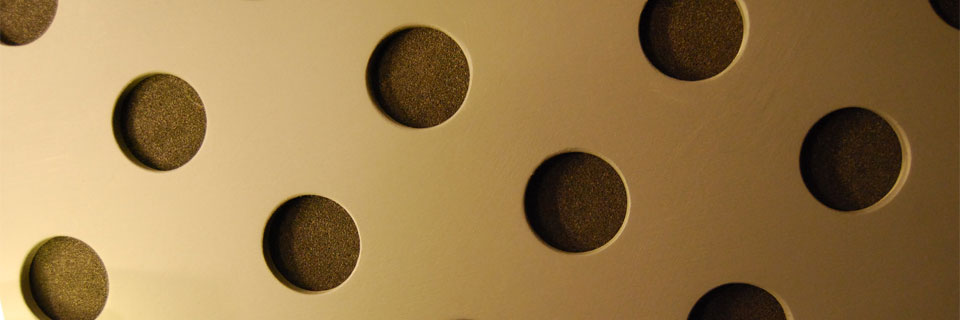This article offers an introduction to the basics concepts of acoustics, hopefully enough for you to diagnose and cure acoustical problems around your production/mixing workstation and in a recording space.
In music and sound recording, the soundwaves that we are most concerned with are the ones that inhabit the so called "audio spectrum" between 20Hz and 20KHz. You will need to be familiar with this concept and have a basic understanding of phase relationships between soundwaves that meet and flat frequency response.
Acoustics is an enormous subject usually best left to the professional studio architect, designer and builder. However, an understanding of some of the basic concepts can be useful for project studio owners who need to remedy problems or take advantage of certain effects.
Why soundwaves diminish (lose energy)
As it travels, a sound wave's energy is slowly lost as heat, through friction. Because a gas, such as the air, presents less friction to a sound wave than a solid, it can travel a longer distance before all it's energy is lost. A solid, on the other hand, will quickly absorb the sound wave, turning its energy into heat, and preventing it from travelling as far.
It's important to recognise that although sound travels faster through a solid object, such as a brick wall, it's energy is quickly absorbed and it will either emerge on the other side quieter or duller or not at all (more on this later).
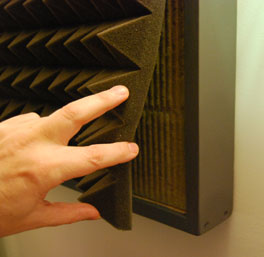 What we need to know
What we need to know
The following are the 4 primary concerns for sound recordists ...
- How to stop sound escaping from a room (disturbing neighbours).
- How to stop sound entering a room from outside and spoiling a recording session.
- How to control the behaviour (reflections) of monitored sound around a mixing/workstation area such that it does not detrimentally alter the true sound of the recording (essential for accurate mixes that will transfer well to other listening environments).
- How to control the direct and reflected sound within a room so that sound reaching a microphone is not spoilt and has the desired balance.
To achieve these you need to consider 2 very different processes ...
- Acoustic treatment
- Sound proofing
To address these issues we must understand how sound behaves within a room and what happens when it encounters an object such as a wall.
What is poor sound?
Poor sound in a studio is usually described as ...
- an imbalance in a rooms frequency response caused by the reflective properties of objects and surfaces
- too much, too little or poor "quality" ambience/reverberation
It is likely that you will need to treat or control reflected sound (reverberation) in 2 locations ...
- The control room, monitoring and mixing area (workstation?)
- The recording area
In the control room, monitoring and mixing area you will need a "natural" balance of ambient sound (a mixture of direct and reflected sound) in which the frequency response is as flat as possible.
In the recording area it is useful to be able to alter the amount of reverberation (reflected sound) for microphone recording purposes. Sometimes we may want to record a live performance completely "dry" (without reverb), and other time we may want some ambience (mix of dry and reflected sound).
How sound behaves in a room
Sound within a room travels, reflects, interacts and generally behaves in a complex way. Sound coming from, for example, a loudspeaker may ...
- Travel directly to the listeners ear
- Reflect off an object or surface before traveling to the listeners ear
- Reflect off an object or surface and then combine with another soundwave before traveling to the listeners ear
- Travel through an object or surface
- Bend around an object or surface
What happens to sound when it encounters an object or surface
Before we consider sound proofing and acoustics, we need to understand the 4 things that can happen when a soundwave hits a surface or object ...
- It is reflected away again
- It is absorbed
- It can travels (or be transmitted) through or bend around it
- A combination of 1,2 & 3
What determines what happens to a sound when it hits an object or surface
Whether a sound is reflected, absorbed, transmitted or bends round is entirely dependent on ...
- The characteristics of the surface
- The size of an object
- The thickness of a surface (such as a wall)
- The wavelength of the sound
The characteristics of the surface
The type of surface on a wall or object will have an effect on what happens to a soundwave when it hits it. For example, a tiled wall will reflect sound better than one covered in wallpaper. A curtain hung in front of a wall will absorb high frequency sound but allow mid and low frequencies through to be reflected (see the effect of wavelength later).
The effect of size, or "thickness", of an object
Sound can bend around objects but the bigger an object is the harder it will be for sound to do this. Remember that sound at 20Hz has a wavelength of 17 meters, and at 20KHz a wavelength of 1.7cm. A basic rule states that to completely absorb (stop) a soundwave, an obstacle must be greater in size, or thicker, than the sounds wavelength.
When an object is large in relation to a sound waves wavelength, the sound will be partially reflected and/or partially absorbed. For example, high frequency soundwaves at 20kHz (with a wavelength of 1.7cm) will be easily reflected or absorbed by walls and ceilings because they will be thicker than the sounds wavelength.
In short, high frequency sound is more easily absorbed than mid and low frequency sound. Walls are not able to absorb soundwaves at 20Hz (with a wavelength of 17 metres) so they will be partially reflected and partially transmitted through.
If the sound wave is a complex wave containing both low and hi frequency harmonics, each harmonic will be affected differently. This explains why low frequency sound is more obtrusive and carries further and we only hear bass frequencies through a door or wall.
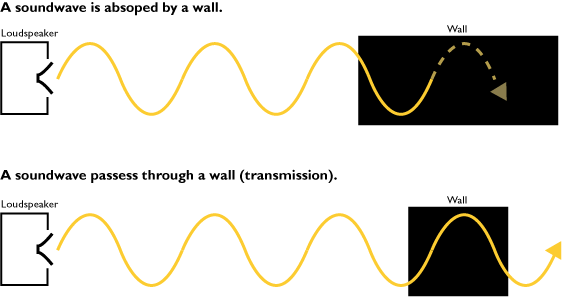
Standing waves & room modes
When one soundwave meets another, a complex interaction occurs in which the phase relationships between the frequencies (harmonics) in the waves interact.
Room modes are essentially problems with the "acoustic geometry" of the room, whereby sound reflecting off walls, ceilings and floors creates unwanted changes in the frequency balance of the sound. Where direct and reflected sound waves meet they can interfere with each other, leading to unnatural increases or decreases in certain frequencies at particular positions within the room. These resulting soundwaves are called standing waves.
The following diagrams show the 2 extremes of this effect and occur when the frequencies are exact integer multiples of the room dimensions.
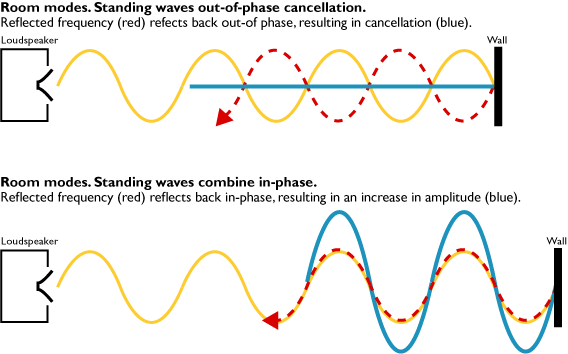
These room modes are generally regarded as being problematic because they distort the true character of the sound. A standing wave occurs when 2 similar frequencies combine to create an unnatural increase or decrease in a frequency. This is most apparent with bass frequencies, but can also create "ringing" flutter echoes with high frequency sound. Try clapping your hands in a tiled bathroom and you will hear this effect.
Be aware that room modes and have a big detrimental impact on your capacity to record sounds with microphones and monitor accurately. You will need some form of treatment if you have problems with room modes.
Soundproofing
Because a gas, such as the air, presents less friction to a soundwave than a solid, it can travel a longer distance before all its energy is lost as heat. A solid, on the other hand, will quickly absorb the soundwave, turning its energy into heat, and preventing it from travelling as far. Of course if the solid object is not too wide, such as a wall, a sound may travel through it, but its overall energy (amplitude) will be diminished.
Soundproofing is the process of trying to prevent unwanted sound entering or leaving a room. You will need soundproofing if you either want to prevent sound leaking out of the room and disturbing family and neighbours or you need to prevent unwanted sound coming in from outside and spoiling your (microphone) recordings.
To stop sound moving through walls, ceiling and floors you need mass, and this generally means building thicker walls and suspended floors and ceilings and fitting double or triple glazing. This is a subject best left to professional builders, but its worth noting that to fully stop a soundwave the obstacle (wall, floor etc) must be wider than the wavelength of the sound. Humans can hear sound with wavelengths between 1.7cm (20KHz, high treble) and 17 meters (20Hz, low bass). Thus it is relatively easy to absorb treble, but extremely difficult to absorb bass. Because it is impractical to build a room with 17 meter thick walls, floors and ceilings(!), combinations of different materials and air gaps are used to try and disrupt the transmission of sound.
By the way, egg boxes have almost no absorption properties whatsoever and are therefore only have minor use in randomising the reflections of very high frequencies.
Acoustic treatment
When a room suffers from poor sound it can be treated with so called "acoustic treatments" to flatten it's frequency response. There are 2 basics acoustic treatment methodologies ...
1. Absorption
Lots of soft furnishings will help with high frequency sound, and cheap duvets hung on walls are a good alternative to expensive professional acoustic treatments.
Build acoustic absorbers to reduce reflections. Combinations of acoustic foam, tiling, rock wall and other heavy thermal and acoustic treatments, and air gaps all have a part to play. You can make your own to hang on walls. Move them around until you find the best location/sound. Try a combination of professional acoustic foam (for hi-frequency sound), with a Rockwool slab behind and a 2-4 inch air gap behind that. These materials often come in 2 x 4 feet sizes which you can mount in a simple battened wood frame.
These kind of absorbers can work well for hi and mid range but you will need to experiment with bass traps across corners to tame bass problems. Bass traps are harder to construct and work by utilising an air gap behind several absorber layers angled across room corners.
Remember that what you are looking for is NOT total absorption of all frequencies, but a good naturally diffuse and controlled pattern of reflections. You need some reflection to prevent the room becoming acoustically dead and unnatural sounding.
2. Diffusion
Make the sound reflections random by having differently angled objects, surfaces and acoustic treatments (diffusers) which will "scatter" the reflections around. Even a bookcase with varying sizes of books and CDs etc can be effective in preventing standing waves. You can built a panel covered with randomly arranged and angled pieces of wood (MDF is good for this).
Ideally you will want non-parallel walls, floors and ceilings around your mixing/workstation area but because this is rarely possible without building work, diffusers and absorbers are a practical alternative.
Technologies
Here are some pictures of some mid/hi frequency diffuser/absorbers that I have built for my home/project studio located in a converted garage. I used solid wood and batons for the frames, with rockwool and dense acoustic foam for mid/low frequency absorption, and either acoustic tiles/foam to absorb/diffuse high frequencies or MDF panels punched with large circular holes to diffuse and reflect mid/high frequencies. I also leave a 2 inch air gap between the absorption layer and the wall. I experimented with positioning to get the best sound.
Note that none of these design deals effectively with low frequency standing waves which often require bass traps situated across room corners.
